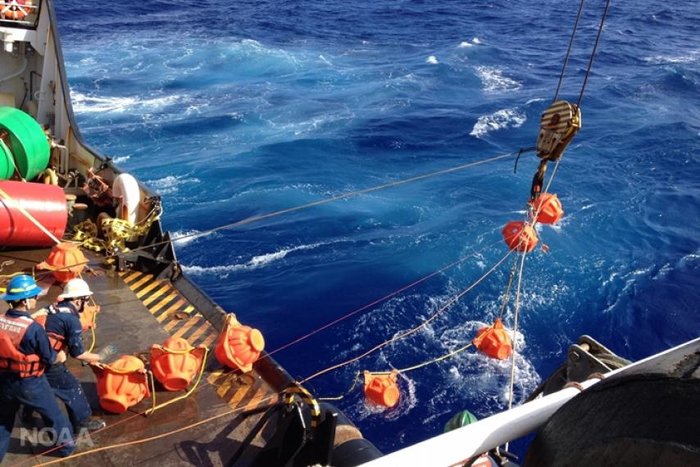Scientists find ocean floor noisier than expected

That’s what they were afraid of. Human activity is creating more ambient noise than ever—Dziak says it’s been on the increase in the oceans since the 1960s, thanks to a growing container shipping industry due to more global commerce. Scientists are beginning to wonder what effect that has on marine animals that use sound to communicate, navigate and feed.
The Challenger Deep mic deployment was part of the initial phase of a NOAA project designed to establish a baseline for ambient noise in the deepest part of the Pacific Ocean. In the future, researchers can use the baseline to determine if noise levels here are growing over time. NOAA already has autonomous hydrophones deployed in shallow ocean waters circling the U.S., from the Gulf of Alaska to Southern California, Massachusetts to Florida, and within the Gulf of Mexico. Mics are also measuring ambient sound near Hawaii and off the coast of Western Samoa.
Challenger Deep, a depression at the bottom of a larger trench known as the Mariana Trench within the Pacific Ocean, was a unique testing ground. It’s near Guam, a bustling, regional hub for container shipping with China and the Philippines—and is 36,000 feet below the sea.
Submerging a microphone into a trough deep enough to fit Mount Everest turned out to be a huge challenge. “The pressure at that depth is incredible,” says Haru Matsumoto, an Oregon State University ocean engineer who worked with NOAA engineer Chris Meinig to adapt a microphone for the job. Atmospheric pressure in the average home or office is 14.7 pounds per square inch (PSI), but at the bottom of the Mariana Trench it is more than 16,000 PSI. The hydrophone, as they called it, was encased in titanium to help withstand the pressure. “We had to drop the hydrophone mooring down through the water column at no more than 5 meters per second to be sure the hydrophone, which is made of ceramic, would survive the rapid pressure change.”
Researchers deployed the hydrophone from the Guam-based U.S. Coast Guard Cutter Sequoia in July 2015. The device recorded sound continuously for 23 days. The next trip to Challenger Deep is planned for early 2017, when the team will deploy a hydrophone for a longer period of time and attach a deep-sea camera to capture any images of nearby organisms.















































